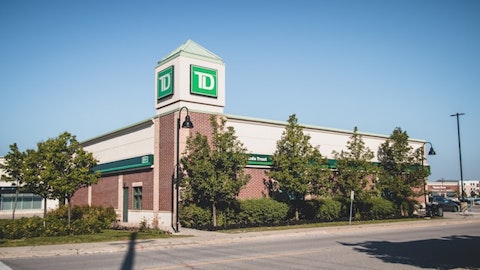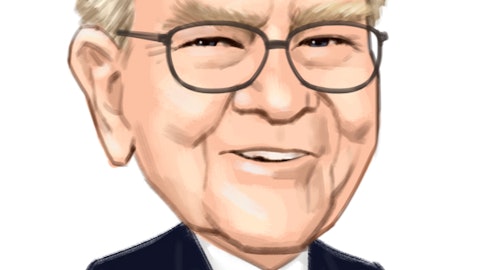Operator: And our next question comes from Matt O’Connor with Deutsche Bank.
Matt O’Connor: Hi. There were some quotes, I think in the media, Jane from you talking about some signs of pressure among the lower end of the consumer. And I appreciate the pie chart that you have in the deck so it’s not a huge percent of the card portfolio. But could you elaborate on that? And then also just address the – you mentioned directionally how the payment rates recovery coming down. But if we look at the growth in spend versus the growth in loans, it is kind of a little disproportionate, I think spends up a couple of percent year-over-year and the loans are [lower FICO]. So as we think about being kind of later cycle, is that something that you’re paying attention to as a potential sign of further weakness in the credit? Thank you.
Jane Fraser: Yes. Look, I think most of the pressure in the lower FICO, we do have a lot of customers in lower FICO. So we’re seeing it out in the market. We’ve got – we obviously have some in the retail services business. We also have to say have the benefit of that loss sharing agreement that really makes a difference there because we’re having to reserve fully for that, but we get it back on the revenue line, as you know. But as we look at the off-us book, as we look at some of the pressures in the market as we look at spending, we can certainly see some of that pressure for the lower FICO, whereas when I think about the cards business, it’s very much driven by the affluent customer. So the affluent is accounting for almost all the spending growth that we’re seeing.
And that’s similar to the numbers that we saw from coming out of the Fed from the deposit side, the excess savings are sitting there, now primarily with households with over $150,000 of income. And it’s down in the rest. So these are things we’re keeping an eye on. I want to be very clear. I’m not that worried about it for Citi, given the prime nature of our card portfolio. And then the rest of our PBWM exposure is obviously is very affluent. But when I look out at the market, I talked to our corporate clients, that’s where we tend to see them be more nervous about the softness in the consumer. And just I call it, they’re much more mindful about where they’re spending, right? So you’re seeing them moving down within a category. They’re certainly looking more on the bargain front.
We’ve been hearing that from our retail partners. We’ve been hearing that across the board. And so growth of card loans is good. Our spend is up but less than loans, I think it’s softening, but it’s not worrying.
Mark Mason: Yes. I think that’s spot on. The only thing I’d add is that when you look at the payment rate, payment rates and branded cards, while they’ve started to come down, they’re still above the pre-COVID level. And we obviously have invested in this business. So the other thing that’s driving this is the new account acquisitions are obviously important drivers of that spend volume and ultimately, that loan growth. But again, there’s nothing that we see outside of what we were expecting in terms of how this portfolio is normalizing.
Operator: And our next question comes from Gerard Cassidy with RBC.
Gerard Cassidy: Good morning, Jane. Good morning, Mark.
Mark Mason: Good morning.
Jane Fraser: Hi, Gerard.
Gerard Cassidy: Jane, as you pointed out, you’re very excited about the opportunities in TTS. You’re winning some new mandates in the custody business. Can you feel on this, is it because the competition is struggling with other issues, what gives you – because it has always been well regarded in this area. So what gives you that added excitement that this is even getting better?
Jane Fraser: Look, I think the added excitement is a lot of it is coming from the investments that we’ve been making, so that we’re – if you look at it in terms of Payment Express, which is live in the U.S., it’s – Thailand is on track for three more markets. That is really a very differentiating capability. The momentum we have in 24/7 clearing, that’s been put in place. We had over $1 billion processed year-to-date, putting our commercial bank clients onto CitiDirect so they have seamless access to our whole PTS network globally had us talking about Citi token services, you can see us innovating with the Fed in new capabilities. So really across the board, it’s that innovation in cutting-edge first in the market type of capabilities.
But you’re putting that on top of a network that’s just unprecedented in terms of its presence, its local capabilities, it’s payroll, cash management, liquidity management, it’s collections, its receivables all sitting on one platform connected globally. And what that gives a client in terms of efficiency saves, insights on data what they can do in terms of risk management and how to really optimize their treasury capabilities. I mean, this thing is a thing of beauty, and it’s very, very hard. It’s very sticky to extract from this because it’s embedded into how our clients do business. It’s that critical and into their technology systems. So when you look at where the world is headed and what’s going on in the world, volatility, these other elements, it’s hard not to see opportunities.
And its opportunities as well with our markets business linked in and one of our really differentiating factors that Andy Morten talks about all the time is his partnership with TTS. In fact, one of our major client bases are corporates, and they have a different profile, let’s say, to an asset manager or a hedge fund, and we uniquely can serve them. So that’s the piece. It’s that combination and trends we see.
Mark Mason: The only thing – I think that’s spot on. The only thing I’d add is that the middle market commercial space is a huge opportunity for us, as you said earlier, leveraging that TTS platform. And then on the security services side, the reality is that we’re finally seeing real traction in North America. Right? We’ve always had kind of strength in many of the other regions, but we’re really winning some major mandates here in North America, which I think is enough to get really excited about.
Jane Fraser: And I think that, to me, is what then drives a lot of the strategy and what we’re trying to do in terms of get to that high quality of earnings, better earnings mix and other pieces that will help us get to that medium-term return target that we are so focused on.
Operator: And our next question comes from Vivek Juneja with JPMorgan.
Vivek Juneja: Hi, Jane. Hi, Mark.
Jane Fraser: Hi, Vivek.





